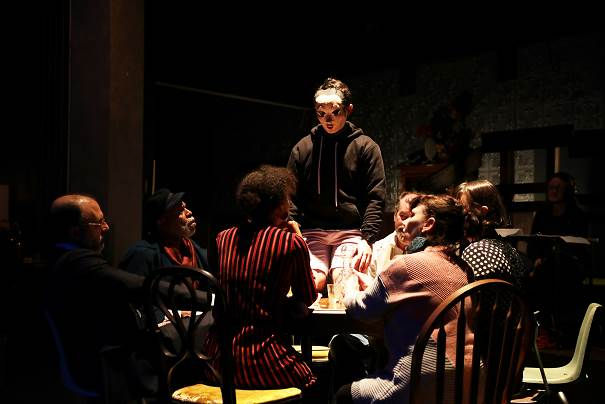Seagullmachine: A Review
- Edward Medina

- Apr 28, 2018
- 3 min read
Updated: Aug 30, 2018

Seagullmachine, now being presented at La MaMa Experimental Theatre Club’s Ellen Stewart Theatre, is the totally immersive creation of The Assembly which describes itself as a collective of multi-disciplinary performance artists committed to realizing a visceral and intelligent theater for a new generation. There are two distinct parts to this creation which was principally conceived by Assembly member Nick Benacerraf with a script by Anton Chekhov, Heiner Muller, The Assembly, and with a nod to William Shakespeare.
The first part has the audience ushered passed an empty performance space and through a door to a performance space with three quarter seating and set pieces and props everywhere. A wall with a metal garage door separates you from the empty space. As you take your seat there are actors milling about, warming up, reading their notes, and laying about on couches or sitting at desks presumably pondering what’s to come. What eventually follows is a traditional execution of Anton Chekov’s The Seagull. The racially diverse and multigenerational cast is as effective as they can be in this relatively staid world. They do shine at times though, and with all candor, the entire ensemble is to be commended for the multiple roles, both real and unreal, they will each pull off during the balance of their time on stage.
After intermission in what is the midst of a performance length of two hours and forty-five minutes we return to Chekov’s Seagull but as the action progresses and at the moment when Konstantin would normally shoot himself a jarring change occurs. Someone begins banging loudly on the garage door. Up to this point the large rolling metal door has been being used as a curtain to a supposed stage set against a field and a distant lake in this play within a play world. What follows is a full blown sequined Baz Luhrmann-like musical extravaganza of the obscure ten-page play Hamletmachine by German postmodern dramatist Heiner Mueller. In addition to the confounding confusion, sight lines are a definite problem here. It doesn’t help that the garage door wall bisecting the set designed by Nick Benacerraf and Emmie Finckel does not prove entirely effective for a good portion of the house observing from the three-quarter round seating.

The next part of the evening has the audience being lead back to the once empty performance space to find themselves surrounded by loud, brash, neon colored costumes on display. Costume designer Kate Fry having been restrained in the first section was now allowed to go all out and her work is quite beautiful in its glorious absurdity. Here in this world the voyeurs are encouraged to walk around, view the costumes, speak to the cast, some of whom have now changed into colorful garb, and even help others change into the clothing on display. There amongst the multitude of flat screens playing images of social destruction and broadcasts of gloom and doom with disco music blaring and dancing encouraged the cast begins recitations and pronouncements until an observer is chosen to be the sacrificial Dane.
This theatrical double play, co-directed by Jess Chayes and Nick Benacerraf, doesn’t ever gel enough to actually work together. As much as they try to make the pieces fit the whole is never greater than the sum of its parts. The Seagull portion is passible and would work well on its own if it didn’t feel as if it was just a long setup for the rest of the show to come. The first half of the Hamletmachine section is just bizarrely out of place and so overblown to everything that precedes it that any hope of it being a bridge to what follows is immediately lost. The colorful, daring, and fancifully shocking madness of the latter part is left to try and make sense of it all. The task is too much for it to bear because everything leading up to that moment feels so distant and unrelated.
Experimental theatre is indeed a risky business. Abstract ideas need to meet real-world dilemmas and then be delivered in a strong and unified voice that leaves the audience moved in ways they never expected in forms they themselves could never visualize as possible. The Assembly may rightly believe there is a conceptual connection to this production but it’s a seemingly thin one. What’s truly missing is a strong enough artistic through line to connect this duo of extremely individual experiences. Shock for shocks sake never works on its own. It needs a solid foundation to land the blow. With Seagullmachine The Assembly is clearly brave enough to take risks they just need to unify the voice they deliver it with.
La MaMa Ellen Stewart Theatre 66 E 4th St 212.254.6468 http://lamama.org/seagull_machine/ $30
From an original post on TheaterScene.



Comments